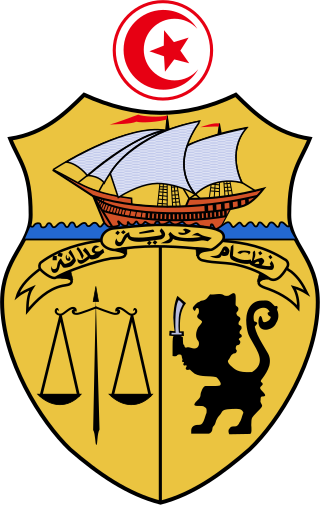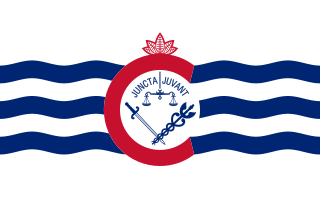
The coat of arms of British Columbia is the heraldic symbol representing the Canadian province of British Columbia. The arms contains symbols reflecting British Columbia's British heritage along with local symbols. At the upper part of the shield is the Union Jack, representing the United Kingdom. The lower portion of the shield features a golden sun setting into the ocean, representing the province's location on the Pacific.

The coat of arms of the state of New Jersey includes:

The Ohio Burgee is the official flag of the U.S. state of Ohio. It is a triangular swallowtail flag. Its red, white, and blue elements symbolize the state's natural features and order of admission into the Union. A prominent disc in the flag's triangular canton is suggestive of the state's name. The flag was adopted in 1902.

The flag of Delaware consists of a buff-colored diamond on a field of colonial blue, with the coat of arms of the state of Delaware inside the diamond. Below the diamond, the date December 7, 1787, declares the day on which Delaware became the first state to ratify the United States Constitution. The colors of the flag reflect the colors of the uniform of General George Washington.

The Beehive Flag is the official flag of the U.S. State of Utah. It is a horizontal tricolor with irregular bands of blue, white, and red. The middle white band contains a blue hexagon outlined in gold. Within the hexagon lies a gold-colored beehive, and below it sits a five-pointed white star.

The flag of West Virginia is the official flag of the U.S. State of West Virginia and was officially adopted by the West Virginia Legislature on March 7, 1929. The present flag consists of a pure white field bordered by a blue stripe with the coat of arms of West Virginia in the center, wreathed by Rhododendron maximum and topped by an unfurled red ribbon reading, "State of West Virginia." It is the only state flag to bear crossing rifles, meant to illustrate the importance of the state's fight for liberty during the Civil War as the southern unionist 35th state.

Michael White is an American politician of the Democratic Party and was the 55th and second longest-serving mayor of Cleveland, Ohio encompassing three four-year terms, from 1990 to 2002. He was Cleveland's second African American mayor as well as the city's second youngest mayor.

The coat of arms of Malaysia is a coat of arms comprising a shield or escutcheon, two tigers for supporters, a crescent and fourteen-pointed star for a crest and a motto. As the Malaysian coat of arms descended from that of the Federated Malay States under British colonial rule, it resembles European heraldic designs.

The Great Seal of the State of Maine was adopted in June 1820. The concept of the design is attributed to Benjamin Vaughan of Hallowell, Maine, while the original sketch is credited to Bertha Smouse, the step-daughter of Col. Isaac Reed of Waldoboro, Maine, who purportedly wrote its official description and explanation. There have been variations in the details of the seal, but the overall design and images remain true to the original. The center of the seal is a shield adorned with a tranquil scene of a moose resting in a field bordered by water and woods; a pine tree stands tall directly behind the moose. On either side of the shield, a farmer rests on his scythe, and a sailor leans on an anchor. Above the shield is the motto "Dirigo" and a stylized North Star. Below the shield is a banner that reads "Maine". The legislature of 1919 decided that the design of the seal should no longer vary, and the design is still used today.

The Great Seal of the State of Illinois is the official emblem of the U.S. state, and signifies the official nature of a document produced by the state of Illinois. The flag of the state of Illinois consists of the seal of Illinois on a white background, with the word "Illinois" underneath the seal. The present seal was adopted in 1869, the flag bearing the central elements of the seal was adopted in 1915, and the word Illinois was added to the flag in 1970. In a 2001 survey by the North American Vexillological Association, the flag of Illinois was ranked 49th out of 72 different flags of states and territories, mainly in the US and Canada.

The Great Seal of the State of Ohio is the official insignia of the U.S. state of Ohio. All governmental offices, agencies, and courts in Ohio use variations of the state seal. Its primary feature is a circular coat of arms that depicts a sunrise in Chillicothe, Ohio's first capital, along with symbols of the state's origins. The seal sometimes appears with the state motto, "With God, All Things Are Possible".

The city flag of Philadelphia is a blue and yellow triband, featuring the Seal of Philadelphia.

The municipal flag of Buffalo is the official banner of the city of Buffalo, New York. The navy blue flag contains a large central emblem consisting of the city seal with 13 "electric flashes" and interspaced 5-pointed white stars emanating from it.

The coat of arms of Tunisia is divided into three parts. The upper part features a Carthaginian galley sailing on the sea. The lower part is itself divided vertically: on the left there is a black scale and on the right a black lion grasping a silver scimitar. Between the two parts is a banner bearing the national motto: “Freedom, Order, Justice”. Finally, at the top of the coat of arms is a circle with a red border into which is inserted the red crescent and star appearing on the flag of Tunisia.

The flag of Wisconsin is the official flag of the U.S. state of Wisconsin. The flag was first adopted in 1863, and was modified in 1979. It is a blue flag charged with the state coat of arms of Wisconsin.

The Opportunity Corridor is a linear project in Cleveland, Ohio, with a boulevard that connects Interstate 77 (I-77) and I-490 to the University Circle neighborhood. "The purpose of the project is to improve the roadway network within a historically under-served, economically depressed area within the City of Cleveland." The corridor is entirely concurrent with Ohio State Route 10.

This article is a timeline of the history of the city of Cleveland, Ohio, USA.

The flag of Cincinnati is the municipal banner of the city of Cincinnati, Ohio, in the United States. The design was selected in an 1896 contest. It was formally adopted on June 15, 1940.

The flag of Knoxville, Tennessee, was officially adopted by municipal ordinance on October 16, 1896. It is the third oldest official city flag in the United States and the oldest flag of any state or city governmental entity in Tennessee.
The City of Springfield, Massachusetts has two official symbols, and is also often represented by depictions of the Municipal Group as a de facto emblem of its government.



















